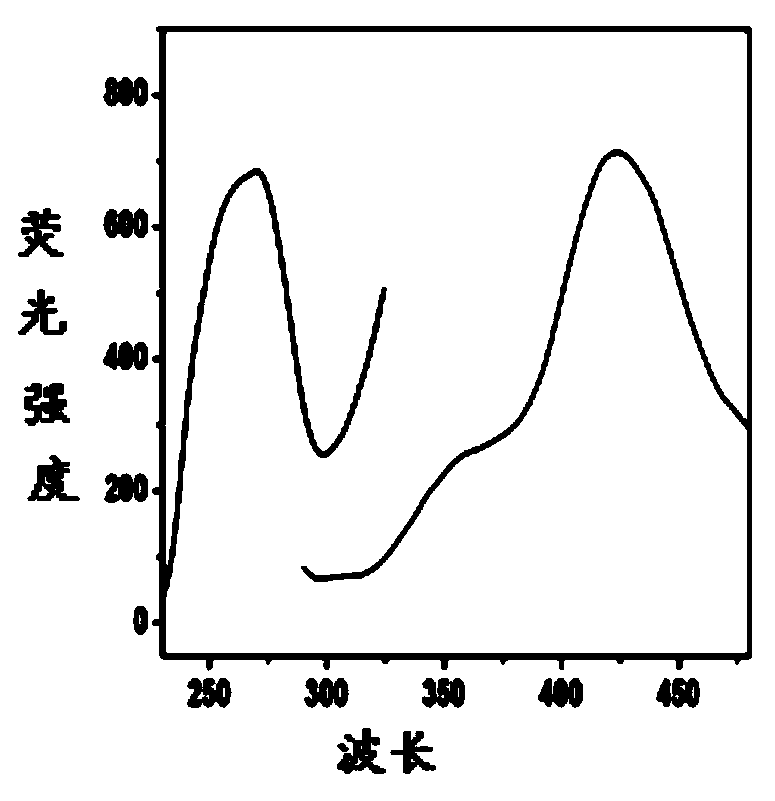Method for preparing polymer protected fluorescent copper nanoclusters
A nanocluster and polymer technology, applied in nanotechnology, chemical instruments and methods, luminescent materials, etc., can solve the problems of less research on Cu nanoclusters, easy oxidation, large size of Cu nanoparticles, etc. Stable performance and mild reaction conditions
- Summary
- Abstract
- Description
- Claims
- Application Information
AI Technical Summary
Problems solved by technology
Method used
Image
Examples
Embodiment 1
[0018] A method for preparing polymer-protected fluorescent copper nanoclusters, comprising the steps of:
[0019] (1) Dissolve 500 μL of polyethyleneimine (PEI) solution with a concentration of 0.1 g / mL and 300 μL of 4-hydroxyethylpiperazineethanesulfonic acid (HEPES) solution with a concentration of 10 mmol / l in 2020 μL of pure water , stir for 5min;
[0020] (2) Add 150 μL of copper nitrate solution with a concentration of 100 mmol / l to the solution in step (1), and stir for 20 min;
[0021] (3) Add 30 μL of formaldehyde to the solution in step (2) under magnetic stirring, and heat at 50° C. for 20 min to obtain a blue solution, which is a polymer-protected fluorescent copper nanocluster. The electron microscope patterns of the polymer-protected fluorescent copper nanoclusters are as follows: figure 1 As shown, the fluorescence spectrum is as figure 2 shown.
Embodiment 2
[0023] A method for preparing polymer-protected fluorescent copper nanoclusters, comprising the steps of:
[0024] (1) 800 μL of chitosan solution with a concentration of 0.1 g / mL and 500 μL of 10 mmol / l 4-hydroxyethylpiperazineethanesulfonic acid (HEPES) solution were dissolved in 1390 μL of pure water and stirred for 20 min;
[0025] (2) Add 300 μL of 100 mmol / l copper nitrate solution to the solution in step (1), and stir for 5 min;
[0026] (3) Add 10 μL of formaldehyde to the solution in step (2) under magnetic stirring, and heat at 70° C. for 50 min to obtain a blue solution, which is a polymer-protected fluorescent copper nanocluster.
Embodiment 3
[0028] A method for preparing polymer-protected fluorescent copper nanoclusters, comprising the steps of:
[0029] (1) Dissolve 300 μL of lysine solution with a concentration of 0.1 g / mL and 600 μL of 4-hydroxyethylpiperazineethanesulfonic acid (HEPES) solution with a concentration of 10 mmol / l in 1980 μL of pure water, and stir for 10 min;
[0030] (2) Add 100 μL of copper nitrate solution with a concentration of 100 mmol / l to the solution in step (1), and stir for 15 min;
[0031] (3) Add 20 μL of formaldehyde to the solution in step (2) under magnetic stirring, and heat at 80° C. for 80 min to obtain a blue solution, which is a polymer-protected fluorescent copper nanocluster.
PUM
 Login to View More
Login to View More Abstract
Description
Claims
Application Information
 Login to View More
Login to View More - R&D
- Intellectual Property
- Life Sciences
- Materials
- Tech Scout
- Unparalleled Data Quality
- Higher Quality Content
- 60% Fewer Hallucinations
Browse by: Latest US Patents, China's latest patents, Technical Efficacy Thesaurus, Application Domain, Technology Topic, Popular Technical Reports.
© 2025 PatSnap. All rights reserved.Legal|Privacy policy|Modern Slavery Act Transparency Statement|Sitemap|About US| Contact US: help@patsnap.com


